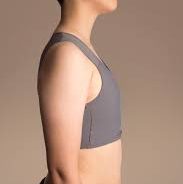Binding is a technique involving compression of the chest to flatten its appearance. While anyone can practice binding, it is most common among transgender male or nonbinary individuals as a form of gender expression. Designated binders exist, but binders can also be made from materials at home such as sports bras or layering shirts. People can practice binding safely by using breathable materials, making sure the compression is not overly tight, and taking “off-days” in which binding is not worn or worn loosely. Binding has been shown to have positive mental health effects. It can make transgender people feel safe and improve their self-esteem by alleviating gender dysphoria and affirming their gender.

Table of Contents
What is Binding?
Binding is a practice in which an individual uses materials such as clothing garments for compression to flatten the appearance of their chest. This is one example of a gender-affirming practice that non-binary and transgender individuals can use.7 While there are many reasons why people may choose to bind, a common one is to reaffirm their gender identity through their appearance in public with a goal of being perceived as the correct gender.5 Binding can also help transgender people feel safer in public. Others may find that binding has private benefits, like relieving gender dysphoria. For many people, binding provides a boost in self-esteem, energy, comfort, and validation, and can significantly improve their quality of daily life.6 While binding may reduce the visibility of one’s chest when a binding material is worn, binders do not have any long-term or permanent chest-reducing capability.
How Do I Practice Binding?
Dedicated binders are purchasable and are the recommended mode of binding by LGBTQIA+ community resources and clinicians. They are available through online vendors like Underworks.com, GC2B.co, F2mbinders.com, and Amazon.com, which sell safe binders designed specifically for the purpose of making one’s chest appear flatter. Additionally, there are sites that offer opportunities to receive a free binder. Visit Transactivegendercenter.org/in-a-bind or Ftmessentials.com to access more information on free binders.7

Because access to and information about binders is fairly limited, some people use alternative binding methods. The most popular methods include sports bras, layering shirts, control-top pantyhose, and compression shirts. Of these, sports bras are the safest method as recommended by healthcare professionals. We acknowledge that the choice to purchase, create, or use a binder is highly personal and factors other than safety such as accessibility, effectiveness, and privacy are critical. These factors may also influence how people choose to practice binding.1
When selecting a binder, one might not know what size to order. Bra-to-binder converters exist on the internet and can provide a reliable measurement that is broadly applicable across binding resources. If the individual cannot recall their equivalent bra size, they may use the following method as outlined below:
- While clothed, use a tape measure to take a snug measurement by wrapping it around the widest part of the chest. (This may be easiest to do while laying down). Measurements may be taken in inches or centimeters. Write this number down or record it somewhere to remember.
- Use the tape measure to measure underneath the chest, where there may be a crease beneath the breast. Write this number down or record it to remember.
- Add the two numbers together, and then divide the resulting sum in half. This number represents your size and should be applicable across binders and brands.
Once one purchases a binder, they should take care to apply or dress it properly. Some resources suggest stepping into the binder, especially newer ones which may feel tight initially. To do this, one should first step into the binder with it inside out and upside down. Then, they should grab the sleeves to pull it up, peeling it and changing the orientation so it is right side up and no longer inside-out. Arms may be inserted into the sleeves now and the bottom can be untucked as needed. Others recommend pulling the binder over one’s head, like putting on a T-shirt, because the binder might get stretched when stepping into it. The binding method is a personal and variable choice and will depend on one’s physical ability and personal preferences. Both methods are safe if one has selected a binder in the recommended size.1
The following is a list of do’s (recommended practices) with regards to binding:
- Remove the binder while sleeping
- Wash the binder regularly
- When not using a binder designed specifically for FTM/N (female to male/nonbinary) binding, make use of breathable materials such as cotton, nylon, or spandex that are porous, absorbent, and breathable
- Take care to look at return policies when browsing for a binder online
The following is a list of don’ts (not recommended practices) with regards to binding
- Do not wear a binder for more than 8 consecutive hours
- Do not sleep in a binder
- Do not wear a binder in a smaller-than-recommended size
- Do not use tape, including duct tape, plastic wrap, or ace bandages as a substitution for a binder1
While the above list is a set of guidelines that is widely applicable to people who bind, the process of finding the right binding method and practice is variable and specific to each individual.

What are the Effects of Binding?
Due to risks regarding health, comfort, and safety, take care to assess pain and discomfort levels while binding. The binder should never cause difficulty breathing or cut into the skin, as both are signs that the binder or binding material is too tight.7 Binding improperly, frequently, or for long durations of time, may result in adverse health outcomes. According to one study, over 97% of individuals who regularly engaged in binding experienced at least one negative side effect. The most reported negative side effects of binding were back pain (53.8%), overheating (53.5%), chest pain (48.8%), shortness of breath (46.6%), itching (44.9%), bad posture (40.3%) and shoulder pain (38.9%).6 The factor most consistently associated with adverse symptoms of binding was frequency, as measured by average days per week that a binding material was worn. It is advisable to take “off-days,” which are days in which the binder is not worn or worn loosely, to prevent these symptoms. Improper binding, which usually refers to binding that is too tight or too intense, can result in adverse health outcomes such as numbness, lightheadedness, fatigue, and weakness. These side effects are not long-lasting and can be stopped or prevented by loosening or removing the binder. Binding with inappropriate, non-soft and porous materials such as plastic wrap, elastic bandages, or duct tape can result in skin conditions, rash, infection, difficulty breathing, and risk physical harm. Failure to wash the binder or binding materials after extended usage may result in skin rashes, infections, or itchiness.1 The associated health impacts and risks of binding may be serious, but with careful monitoring of side effects and breaks, it is possible to practice binding safely.
In the same study as mentioned above, researchers gauged changes in participants’ mental health and moods to assess the psychological effects associated with binding. Their results almost unanimously showed self-reported mental health benefits, including decreases in suicidality, anxiety, and gender dysphoria along with increases in self-esteem, confidence, and feeling safe in public. The percentage of participants that reported feeling either “positive” or “very positive” increased from 7.5% without binding to 69.9% with binding.6 Participants surveyed in the study consistently suggested that the positive effects of binding, as listed above, “outweighed” the negative symptoms or side effects. These findings suggest a strong gender-affirming and validating effect of binding, associated with positive changes in mood and affect. When discussing binding with patients, clinicians should consider both the physical and mental health effects associated with binding in combination with personal factors to formulate a highly personalized recommendation that maximizes a patient’s safety and comfort while validating their identity.3

Are There Alternatives to Binding?
For many people, binding helps reduce gender dysphoria and affirming their gender through their physical appearance. However, binding does not yield permanent effects, and it is not recommended to practice binding every day without pause. If one desires a more permanent treatment method to reduce gender dysphoria caused by their chest, they may look into masculinizing chest surgery, otherwise known as reduction mammaplasty or “top surgery.” In this procedure, which is performed by a plastic surgeon in a formal medical setting under general anesthesia, the goal is to remove breast tissue and excessive skin and reduce and reposition the nipple and areola to alter the patient’s chest to align with their gender identity.2 In a 5-year retrospective review conducted on all FTM transgender patients who underwent masculinizing chest surgery, the pooled overall patient satisfaction from the studies included in the meta-analysis was 92%, suggesting that most individuals who undergo the procedure are satisfied with the results long-term4. More information on this procedure and other gender-affirming procedures can be found in our article on Transition and Sex Reassignment.
Concluding Remarks
Binding is a common gender-affirming practice among transgender males and nonbinary people. Purchasing and selecting a binder is a highly personal decision, but it is medically recommended to use a binder that fits properly (i.e. does not squeeze the body too tightly) and is made of a porous, breathable material. It is also recommended to take “off-days” from wearing a binder to avoid adverse health outcomes such as back pain, overheating, and chest pain. One should wash their binder frequently to avoid skin infection or rashes. Despite these risks, wearing a binder provides many people with relief from gender dysphoria, along with boosts in self-esteem, mood, and feeling safe in public. Due to the short-term nature of binding, some people who want to alter the appearance of their chest undergo reduction mammoplasty, which is a gender-affirming surgery that involves the removal of breast tissue and restructuring of the nipple-areola complex.
Binding Resources:
- Free binders:
- FTMEssentials Free Youth Binder Program: Offers free binders to individuals under the age of 24 who can’t afford to purchase a binder. Requires a brief application
- Chest Binder Donations: Free Chest Binders for Trans People in Need: Offers free binders to transgender-identifying individuals of all ages who can’t afford to purchase a binder. Requires a brief application
- Places to purchase binders:
- Gc2b: Sells full- and half-length binders in a variety of colors, including skin tones, black, white, and other colors (Price range: $33-35)
- Underworks: Sells full- and half-length binders in black or white as well as binders designed to be worn while swimming, different styles of compression tops, and briefs designed to hold packing devices (Price range: $17-85.)
- F2mbinders.com: Related to underworks, sells binders in a variety of styles and lengths
- UCSB resources:
References:
- FTM breast binding guide and safety before surgery. Gender Confirmation. (2020, July 28). Retrieved November 9, 2021 .
- Masculinizing Chest Reconstruction (“Top surgery”). Masculinizing Chest Reconstruction (“Top Surgery”) | Gender Affirming Health Program. (n.d.). Retrieved November 9, 2021.
- Moffa, J., & Pickle, S. (2019, April 9). Chest Binding: A Physician’s Guide. Pride in Practice. Retrieved November 9, 2021
- Nelson, L., Whallett, E. J., & McGregor, J. C. (2009). Transgender patient satisfaction following reduction mammaplasty.
- Olson-Kennedy, J., Warus, J., Okonta, V., Belzer, M., & Clark, L. F. (2018). Chest reconstruction and chest dysphoria in transmasculine minors and Young Adults. JAMA Pediatrics, 172(5), 431.
- Peitzmeier, S., Gardner, I., Weinand, J., Corbet, A., & Acevedo, K. (2016). Health impact of chest binding among transgender adults: A community-engaged, cross-sectional study. Culture, Health & Sexuality, 19(1), 64–75.
- Understanding Binding: A Resource Guide for Parents of Transgender Youth. Children’s Hospital of Los Angeles. (2019). Retrieved November 9, 2021.
Last updated: 9 November 2021
